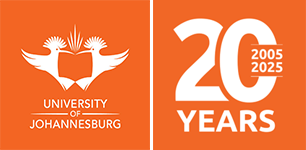
Sustainable commuting tracking
Home » About UJ » SDG Impact » SDG 11: Sustainable Cities and Communities » Sustainable commuting trackingSustainable Commuting: Tracking and Measurement
UJ Annual Reports: Energy Management – Carbon Footprint
UJ Facilities Management Annual Reports
UJ Carbon Footprint: Inter-campus Bus Transport Carbon Emissions Data 2023
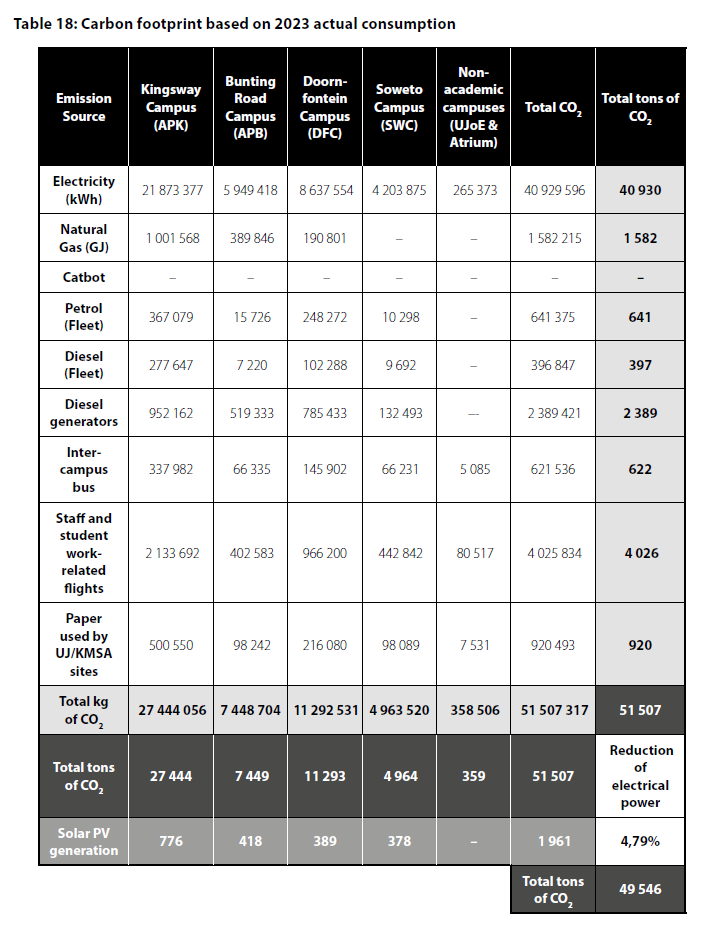
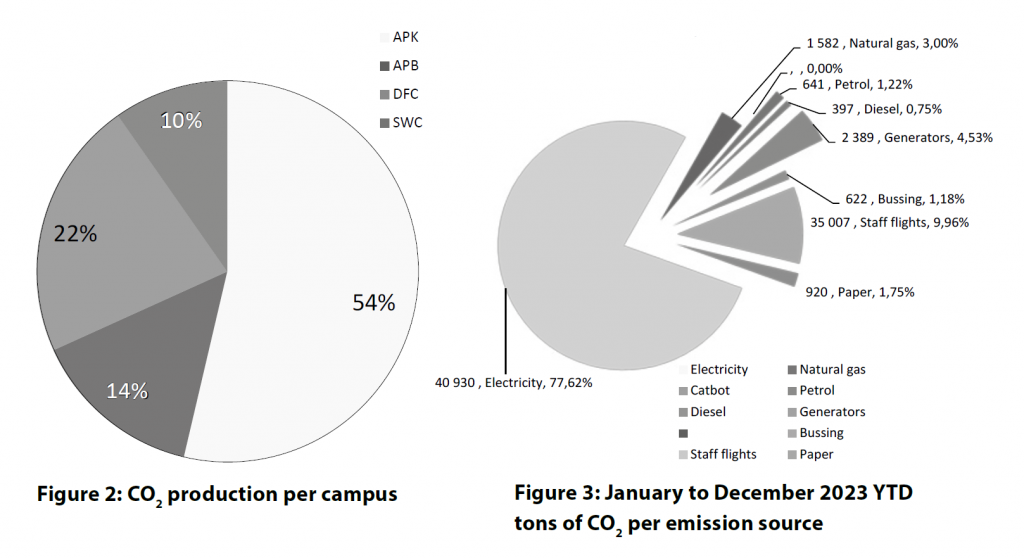
UJ Energy Plan
UJ Energy, Resource, Waste and Sustainability (ERWSus) Plan
UJ Spatial Development Framework (SDF)
UJ Sustainability Report
UJ Electric Buses
- https://news.uj.ac.za/news/uj-unveils-electric-buses-a-first-for-a-south-african-university-2/
- https://news.uj.ac.za/news/ujs-electric-buses-pioneering-sustainable-transportation-and-redefining-campus-mobility/
- https://news.uj.ac.za/news/vice-chancellor-message-17-february-2023-2/
- https://youtu.be/QGJDADs8JWs
- https://youtu.be/qZu3VdR1IYI
- https://joburg.org.za/media_/Newsroom/Pages/2022%20News%20Articles/November/UJ-in-bold-move-to-cut-carbon-footprint-with-new-electric-bus-service.aspx
- https://www.engineeringnews.co.za/article/uj-launches-two-electric-buses-to-cut-its-emissions-2023-02-15
- https://www.thesouthafrican.com/news/uj-unveils-electric-buses-18-february-2023-breaking/
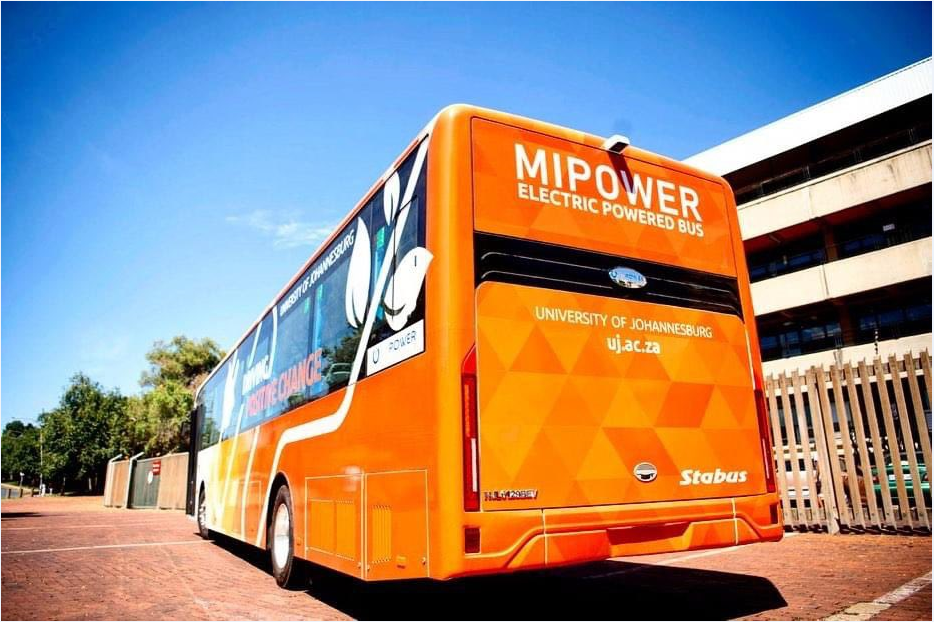
UJ unveils electric buses – a first for a South African university
📅 Date: February 15, 2023
The University of Johannesburg (UJ) has unveiled its new electric vehicle (EV) buses, in what is a first for a South African university. The EV buses, which will be added to the existing fleet, have already begun ferrying students between various campuses.
The buses are the latest innovation in UJ’s ongoing efforts at going green, as part of the University’s plans to reduce carbon emissions, in line with the United Nations Sustainable Development Goals (SDGs). UN Sustainable Development Goal 11 defines green cities as those that are dedicated to achieving environmental, social, and economic sustainability, with a focus on minimising inputs of energy, water, and food, and drastically reducing waste, heat output, and pollution. UJ has, in recent years, made strategic moves to improve its sustainability footprint.
On Tuesday, 7 February 2023, there was excitement all around as one of the two brightly painted EV buses, branded in UJ’s signature orange and white, pulled out of Auckland Park Kingsway (APK) Campus into Joburg’s morning traffic. Aboard the bus were members of the University’s Executive Leadership Group (ELG), who were travelling to a meeting at one of the University’s off-campus venues in the city. And true to its nature, and unlike its diesel counterparts, the electric bus did not belch any toxic fumes. Not only do the EV buses produce much lower carbon emissions, but they also perform well, offering a smooth ride even on steep routes.
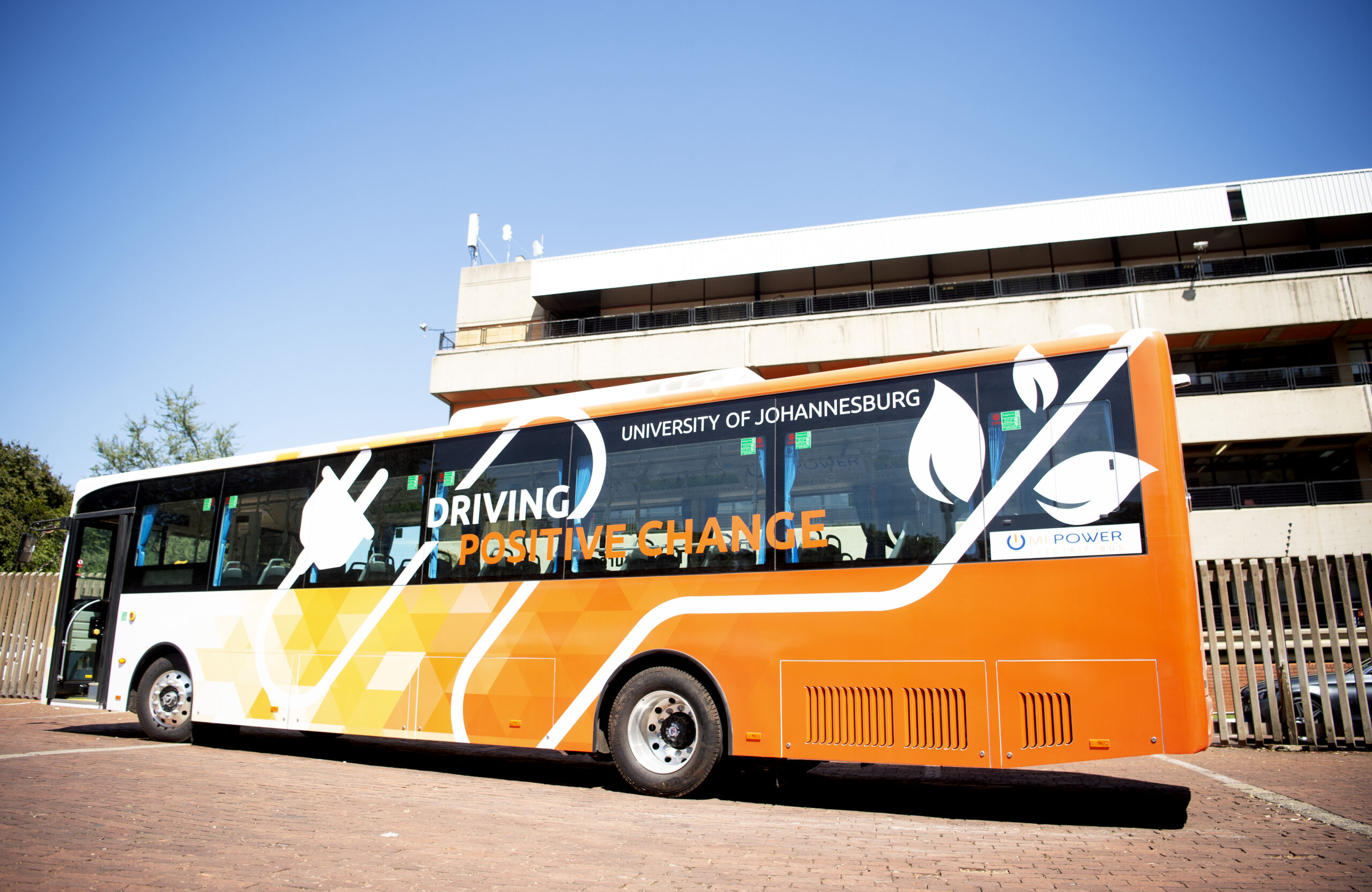
Decreasing UJ’s carbon footprint
Special Projects advisor Professor Andre Nel explained the process that led to this project coming to fruition. “It started more than 18 months ago, as part of our drive to reduce our carbon footprint at UJ. We’ve always had a strong focus on sustainability issues. After implementing large numbers of solar panels, one of the next questions was how can we further make UJ sustainable? After some research, the obvious answer was how we were going to cut our carbon emissions in one area, and that area was transport. Transport makes up about four-and-a-half percent of UJ’s footprint and reducing that in any way is something we desired”.
So what will happen when load shedding strikes and the buses can’t be charged? And what about their environmental friendliness, given that they are charged using coal-generated electricity? Dr Mpoti Ralephata, UJ’s Chief Operations Officer, was quick to allay such concerns. He said 15% of our energy at UJ comes from solar, which is enough to power the buses. “We will have to have loadshedding for more than five hours a night to affect overnight charging,” he said.
4IR in action
Among those aboard the buses was Dr Nolitha Vukuza: Senior Executive Director: University Relations, Student Affairs and UJ Sport. “My experience is quite unprecedented because I’ve never been on an electric bus before. This is a day of celebration… We keep on talking about the fourth industrial revolution, and today it’s all about 4IR in action. I am also happy that the new VC (Vice-Chancellor and Principal Designate, Professor Lethlokwa Mpedi) has been talking about 4IR for societal impact. What a way to make it impactful,” she said, shortly before the bus drove off.
The buses may at first glance – and from a distance – give the impression that they are part of the generation of the existing fleet. It’s only once you hop on that you realise that you have indeed entered into the fourth industrial revolution. Most impressive is the amount of noise you will experience while the bus is running. Unlike the normal diesel-powered engines, the EV buses are almost silent – with the loudest sound being the humming of the air conditioning system. Each bus has a capacity of 76 passengers, with 57 seated and 19 standing.
For added safety, the buses are fitted with closed circuit television (CCTV) cameras and stop buttons. The stop buttons make communication with operators easier, as passengers can draw the driver’s attention without being intrusive when approaching their destination. Adding to the high-tech design of the buses is that they are equipped with USB charging ports so that passengers can keep their gadgets running while onboard, for convenience.
To get a bus fully charged, it would need to be left on the plug point for at least five-and-a-half hours. But that’s time worth investing in because it powers the bus enough to enable it to cover up to a 350 km range. The distance is significantly less than the 200 km of the entire bus route that the buses will cover. There are currently two charge points for the buses, one on campus and one at the bus depo.
An added beauty of these buses is that they are a gift that keeps on giving. Over the average 15-year lifespan which is expected that a bus will cover, these buses will save on fuel costs. Another advantage is that they require less maintenance than their diesel counterparts. Due to the high-tech nature of the EV buses, and specifically because of the new technology that they come with, it is envisaged that drivers will be retrained in how to handle this fleet.
Prof Mpedi was brimming with excitement at seeing the University’s vision come to life: “These buses are an example of 4IR in action. They are part of a legacy that we want to leave for future generations. As a testament to our position as a leader, we are the first university to make use of EV buses for commercial purposes.”
Prof Mpedi added that the buses are aligned with the institution’s sixth strategic objective, which is ‘fitness for global excellence and stature’. “These buses are a tangible contribution towards achieving that goal. They are also a physical manifestation of our commitment towards the goal of being a sustainable institution that strives to implement improvements and actions across all spheres of its campus activities. We firmly believe that sustainable development is a long-term commitment. We aim to contribute to sustainability by reducing our environmental footprint while enhancing our contributions to the social and economic development of South Africa.”
UJ’s electric buses: pioneering sustainable transportation and redefining campus mobility
📅 Date: August 24, 2023
Just over five months ago, the University of Johannesburg (UJ) in a game changing move unveiled two new electric buses that will join the institution’s existing bus fleet.
As the excitement dies down, the question that has remained on everyone’s mind is: will these busses be useful to the University community? The answer, it seems, is a resounding YES!

“The University of Johannesburg is constantly looking for ways and means to reduce its carbon footprint and make a positive impact on our environment. This started with a pilot project, an electric bus to see whether it will fit into the current fleet of internal combustion engine buses and to also determine if it will be suitable for the route that we use to ferry our students. After being satisfied with how the pilot bus performed, we then acquired at the beginning of 2023 two more electric buses,” Prof Mpedi said.
He added that these buses are a long-term investment that not only saves the institution some much needed money, but also ushers it towards a green, clean future.
“Electric buses do not have many moving parts, so we save money when it comes to servicing these buses. We also save on diesel. So, this is really an exciting thing for the university. A lot of people have asked that with the current loadshedding situation, will UJ not run the risk to have their buses stuck on the side of the road? We’d like to assure them and make them aware of the fact that at UJ, 15% of our energy comes from solar. We have solar plants at our campuses, and we use this to charge our buses. Obviously, 15% is not enough, and as and when resources permit, we are going to use renewable sources of energy.”
Driving innovation for a sustainable society: UJ’s role in the 4IR
One of the University’s strong points is the focus on 4IR and innovation and how the gains made from these can impact positively the society it exists in. Speaking more on this, UJ Director of Logistics Dr Martin Siluthanyi said the adoption of the electric buses came with an important introspection- which began with finding out just how much carbon emissions UJ is responsible for.
“We are the institution of the Fourth Industrial Revolution, driven by innovations. There is an international challenge of Carbon Emissions, and we thought about how we can be part of the solutions. We looked at our vehicles first. Our vehicles at UJ contribute about 40% of the institution’s total carbon emissions. One of the tasks we were given is to figure out how we can de-carbonize and reduce these carbon emissions. That’s when we brought along this new child [the buses].”
Dr Siluthanyi added that true to UJ’s trailblazing nature, the University is the first higher education institution in sub-Saharan Africa, to have these EV Buses.
Student voices: embracing the electric bus experience
The reviews from the main users of the electric buses, have been nothing but stellar. Undergraduate student Adesewa Dotun-Soyege said she loves the aesthetic of the buses.
“I really appreciate that we don’t have to pay for these electric buses. Secondly, these buses are appealing to us as students because they are new, future-focused, and just the whole aesthetic of the buses is cool. The buses are also quiet, so it’s much better to study on these buses. As a student I am always looking for the safest, fastest, and cheapest option, and these buses are it!”

Fellow undergraduate student Thapelo Tshamano said in terms of comfort and convenience, these buses are a cut above the rest.
“I have noticed a great difference in terms of comfort and convenience. If I were to compare, the traditional ones make a louder noise, than this electric one. In this one I can study, relax in-between campuses and if you’re preparing for a test, you can finish your preparations on the bus,” he said.
Wana Mubita, a Postgraduate student said she’s most impressed by the commitment coupled with action from UJ, to make a contribution to the ending of climate change is commendable.
“I feel like UJ is taking part in creating sustainable development and societal impact, which SDG 13, Climate Change. These buses are reducing carbon emissions, and thus contributing to the reduction of air pollution.”
